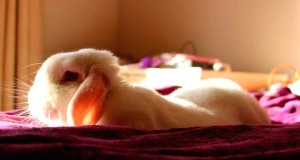WHAT IS MY RABBIT SAYING WHEN HE….

Lucy the house rabbit shows she is relaxed by stretching out. copyright Kassie Woods
Rabbits are prey animals and have to stay quiet to avoid being eaten by predators. So they don’t use many sounds to communicate. They spend a lot of their time underground in their burrows so even body language is also not much use in the dark. Scent is therefore a very important way of communication for them. Their droppings are coated with anal gland secretions and they rub their chins to mark noticeable parts of their territory like grass humps or flat stones (McBride 1998)
- LICKS me. This is a sign of affection like kissing. Rabbit friends groom each other (Crowell-Davis 2010).
- NUDGES. Sitting close to you or another rabbit is also a sign of affection (Crowell-Davis 2010).
- THUMPS his back legs. This is a warning sign. Something has upset him. This may also be used as a way to get your attention.
- EARS forward. He is relaxed and interested.
- LIES on his side with his hind limbs stretched out. He’s warm and relaxed (Crowell Davis 2010). Rabbits sunbathe like this.
- CROUCHES low on the gound with his ears flat against his neck. He is frightened or, there’s another rabbit around he is showing submission (Crowell-Davis 2010)
- GRUNTS or GROWLS. He is definitely fed up with something. May be guarding his territory from you (Bays, et al., 2006).
- NIPS. A gentle nip may simply be the way a rabbit tells you to get out of the way.
- BITES. This is to make you retreat. He will usually be frightened. Or he may just have learned that biting is a good tactic. It can be used as a way to get attention.
- CHIN RUBBING. Your rabbit is marking his territory with the scent glands under his chin. Other rabbits will sniff the mark and can tell if the chinner is male or female, and if they are ready to mate (Soares & Diamond, 1982). Rabbits also chin rub against each other. Chinning may also help establish a group or family scent (Hudson & Vodermayer, 1992)
- PURRS or gentle teeth clicks. He is happy.
- GRINDS his teeth known as bruxism. This is usually noisier than teeth clicking and the rabbit’s body doesn’t look relaxed. His eyes may be bulging. Teeth grinding can be the sign of a sick rabbit (Bays et al., 2006).
- PEES ON ME. He fancies you (McBride 1998). This is male rabbit courtship behaviour. It’s the rabbit equivalent of giving you a bottle of perfume. Unless your idea of romance is a horny male rabbit, get him neutered now. Peeing can also be used against rival rabbits in an aggressive encounter (Hawkins et al., 2008) so it might also be a sign he sees you as a rival – though this is less likely.
- CIRCLING ROUND ME. Your rabbit fancies you. If she’s female she may be in season. Get her spayed now! (Hawkins et al., 2008). If your rabbit is just going round in circles without focusing on you or another rabbit, then this can be a symptom of hydrocephalus and you should take it to the vet.
- BINKYING. This is the amazing moment when he leaps into the air and twists round before landing. Scientists call this play gamboling (Hawkins et al., 2008). He is joyful and playful.
- SCREAMING or YELPING. Rabbits in fear of their lives emit a high- pitched scream. Little squeaks are often excitement.
- NEST BUILDING. Female gathers nesting material and pulls out her fur to line the nest. May be false pregnancy. Consider spaying.
- STIFF LYING ON BACK. Rabbit is terrified and is doing the death feint.
REFERENCES
Bays, T. B., Lightfoot, T. & Mayer, J., (2006) ‘Behavioural assessment’, Available at www.supremepetfoods.com/wordpress/wp-content/uploads/2012/03/Behavioural-assessment.pdf Accessed February 12 2013
Crowell-Davis, S. L., (2010), ‘Rabbits’, ed Tynes, V. V., Behavior of Exotic Pets, Chichester, UK, Wiley-Blackwell, 69-77
Hawkins, P., Hubrecht, R .,Buckwell, A .,Cubitt, S., Howard, B.,Jackson, A., & Poirier, G. M., (2008), Refining Rabbit Care, A resource for those working with rabbits in research, RSPCA & UFAW. Available at www.rspca.org.uk/sciencegroup/researchanimals/implementing3rs/refiningrabbitcare Downloaded February 11 2013.
Hudson & Vodermayer (1992), ‘Spontaneous and odour-induced chin marking in domestic female rabbits,” Animal Behaviour, 43, 329-336
McBride, A., (1998), Why Does My Rabbit…?, London, UK, Souvenir Press.
Soares, M. J. & Diamond,M., (1982), ‘Pregnancy and Chin Marking in the Rabbit, Oryctolagus cuniculus,’ Animal Behaviour, 30, 941-943